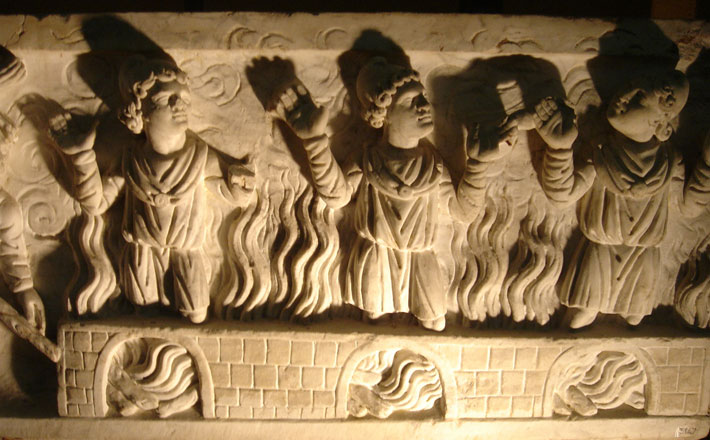Commentary on Daniel 3:1-29
As the story begins, the Babylonian king, Nebuchadnezzar, erects a massive golden statue and commands that all must bow before it.
Initially, it appears that the central conflict of the story involves idolatry. However, as the story progresses, a different conflict emerges — that between the kingship of Nebuchadnezzar and the power of God. The story alerts the reader to this conflict in Daniel 3:15 when the king, furious with Daniel’s friends, threatens them saying, “who is the god that will deliver you out of my hands?”
This court tale about Shadrach, Meshach, and Abednego is part of a larger series of stories in Daniel 1-6 dealing with the relationship between the God of Israel and the gentile kings.1 At times, the foreign king recognizes that the source of his power is the God of Israel and publically announces that fact (Daniel 2:47). At other times, however, the kings are recalcitrant and refuse to recognize the ultimate sovereignty of God. They try to claim their power as their own, and, in doing so, they create intense conflict and danger for the Jewish community caught in the middle of the struggle. This is the situation in which Daniel’s friends find themselves. At the end the previous chapter, Nebuchadnezzar had announced that true knowledge and true power comes from Daniel’s God. But at the beginning of Daniel 3, the king seems to have forgotten his earlier confession, and, at the prodding of some Babylonian sages (the Chaldeans), he entraps the Jewish friends and arrogantly dismisses their God.
What is puzzling, however, is Shadrach, Meshach, and Abednego’s answer to the king: “If our God whom we serve is able to deliver us from the furnace and out of your hand, O king, let him deliver us. But if not, be it known to you … that we will not serve your gods … ” (Daniel 3:17-18). This response, accurately conveyed in the NRSV but emended in other popular translations, does not appear to be an enthusiastic defense of God’s sovereignty. It suggests that they have doubts about God’s power to rescue them and are not confident that God will do so. C.L. Seow argues, however, that the friends’ response conveys an unconditional and absolute faith.2 Their devotion to God is not based on any kind of quid pro quo from the LORD. Unlike Jacob who attached all kinds of strings to his commitment to God (cf. Gen 28:20-22), the friends announce that their dedication to God is absolute, regardless of what happens to them.
Comic relief, comic resistance
In the midst of tension and conflict created by this clash of sovereignty, the story offers some good comic relief. Notice the long lists of government officials and musical instruments that are repeated so frequently and so unnecessarily (Daniel 3:2, 3, 5, 7, 9, 15). The repetition of these complicated lists creates exaggeration and makes the king and his officials look silly. Moreover, as the story unfolds, the king comes off looking rash and easily manipulated: the king begins the story with an arrogant command, then becomes the pawn of his jealous officials who wish to get rid of the Jewish wise men. He then flies into a rage when the Jewish men do not obey them, but ends by blessing their God!
The satirical elements serve an important purpose. They help negotiate the conflicts that might arise between the Jewish community’s fidelity to God and its dealings with gentile kings. By showing him to be bumbling and blind, the story undermines the king’s fearfulness and tyranny and encourages resistance. At the same time, the story shows the king to be teachable — he learns to show honor to the true God. Thus God is shown to accommodate the king and also vindicate the participation of the Jewish men in the gentile government.
Survival and deliverance
Despite the story’s comic playfulness, its liturgical context in the Christian lectionary — the Great Vigil of Easter — highlights the weighty theme of deliverance from death. The three friends of Daniel, despite being bound in their clothes and tossed in, survive the overheated furnace and come out unbound and physically unharmed. In the midst of the fire’s damaging flames, there is a fourth person who looks like a man but has “the appearance of a god” (Daniel 3:25) or, literally, “a son of a god.” Although the Hebrew text does not tell us exactly who this figure is or what he does in the furnace, he seems to be an angel of the Lord who has come to protect and deliver the three. In some medieval interpretations, this angel is Michael.3 For many Christian interpreters, however, the language of “a son of god” suggests that the fourth figure is Christ.4
The clash between the power of God and the forces of the world; deliverance from an unjust death at the hands of the empire; a miraculous “son of god” not bound even by death; hope for physical restoration and resurrection (see Daniel 12:3) — these are some of the thematic links connecting Daniel 3 and the Great Vigil of Easter.
The story has continued to inspire resistance for communities facing unspeakable injustice. Jewish activist and holocaust survivor, Elie Wiesel, reminds readers that we live in a world where our neighbors continue to face the threat of eradication through fire and violence. Wiesel describes seeing the fires of the crematoriums as he and his fellow Jews, crowded into train cars, approached the concentration camp. His life reminds readers that while Daniel’s friends survived the fiery furnace, the gas chambers and crematoriums claimed millions more. For him and others who lived through and resisted injustice, Daniel and his friends offered hope for survival.5 What is more, the story serves as a reminder that we are all called to the work of faithful resistance.
Notes:
1 See further, C. Newsom, “Political Theology in the Book of Daniel: An Internal Debate,” Review and Expositor 109 (2012):557-568.
2 C.L. Seow, Daniel (Westminster Bible Companion; Louisville: Westminster/John Knox, 2003), 57-58.
3 C. Newsom and B. Breed, Daniel (Old Testament Library; Louisville: Westminster/John Knox, 2014), 97-127.
4 J. Collins, A Commentary on the Book of Daniel (Hermeneia; Minneapolis: Fortress, 1993), 190.
5 Newsom and Breed, Daniel, 114-118. Breed points out that Mohandas Gandhi and Martin Luther King, Jr. also called upon these stories from Daniel in the midst of their civil rights movements.


April 4, 2015